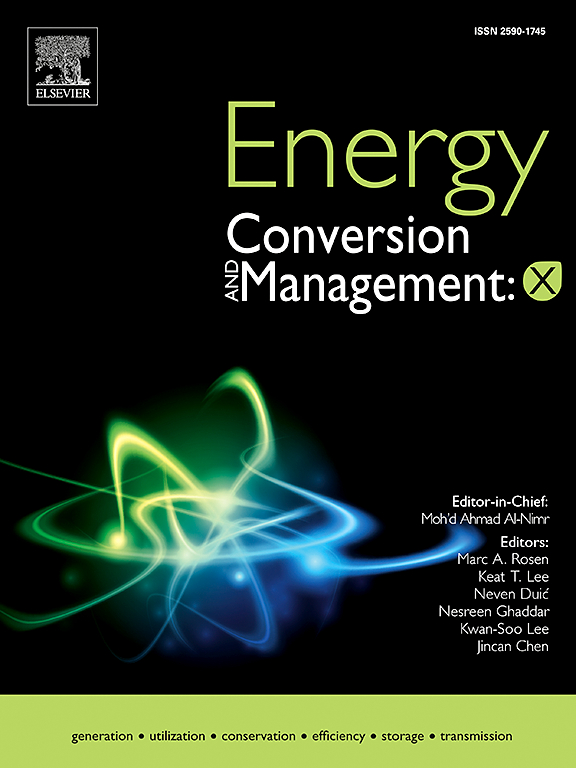多尺度融合图卷积网络用于多站点光伏发电预测
IF 10.9
1区 工程技术
Q1 ENERGY & FUELS
引用次数: 0
摘要
基于精细时空关系挖掘的多站点光伏电力预测由于具有降低建模成本和提高预测精度的潜力,近年来受到了广泛关注。然而,现有的方法往往忽略了现实场景中多个地点在不同时间尺度上复杂多变的时空相关性。为了解决这一限制,本研究从多尺度角度提出了一种新颖有效的模型:多尺度融合图卷积神经网络(MSF-GCN)。MSF-GCN集成了一个多图卷积(MGCN)块,该块利用预定义和自适应可学习的图来捕获基于不同时间尺度观测数据的光伏站点之间的不同空间依赖性。此外,设计了一个轻量级的分解双向融合(DBF)块来提取尺度间和尺度内的相关性。该块允许来自低尺度的细粒度信息增强在高尺度上的微观特征提取,而来自高尺度的粗时间变化则为低尺度提供了发电模式的宏观视图。此外,该模型采用结构相同但权重不共享的多预测因子,以同时利用多尺度数据的不同特征和互补预测能力。在两个开放存取数据集上的实验结果表明,所提出的MSF-GCN在保持良好运行效率的同时,在准确率方面始终优于现有方法。在预测精度方面,我们的模型比最先进的时空模型在MAE和MSE方面平均高出13.21%和28.48%。MSF-GCN中多尺度、MGCN和DBF的消融分别使MAE平均增加55.86%、47.49%和44.55%,进一步证明了所设计结构的有效性。本文章由计算机程序翻译,如有差异,请以英文原文为准。
Multi-scale fused Graph Convolutional Network for multi-site photovoltaic power forecasting
Multi-site photovoltaic power forecasting with refined spatiotemporal relationship mining has recently gained significant attention due to its potential to reduce modeling costs and improve accuracy. However, existing approaches often overlook the complex and varying spatiotemporal correlations across different time scales among multiple sites in real-world scenarios. To address this limitation, this study proposes a novel and effective model from a multi-scale perspective: the Multi-Scale Fused Graph Convolutional Neural Network (MSF-GCN). The MSF-GCN incorporates a Multi-Graph Convolution (MGCN) block that utilizes both predefined and adaptive learnable graphs to capture diverse spatial dependencies between photovoltaic sites based on data observed across different time scales. Additionally, a lightweight Decomposed-Bidirectional-Fusion (DBF) block is designed to extract inter- and intra-scale correlations. This block allows fine-grained information from low scales to enhance the extraction of microscopic features at higher scales, while coarse temporal variations from high scales provide lower ones with a macroscopic view of power generation patterns. Furthermore, the model employs multi-predictors with identical structures but unshared weights to leverage both distinct features and complementary forecasting capabilities from multi-scale data simultaneously. Experimental results on two open-access datasets demonstrate that the proposed MSF-GCN consistently outperforms existing methods in terms of accuracy while maintaining favorable run-time efficiency. In terms of prediction accuracy, our model outperforms the state-of-the-art spatiotemporal model by an average of 13.21% for MAE and 28.48% for MSE. The average increase in MAE of 55.86%, 47.49%, and 44.55% resulting from the ablation of the multi-scale, the MGCN, and the DBF in MSF-GCN, respectively, further justifies the effectiveness of the designed structures.
求助全文
通过发布文献求助,成功后即可免费获取论文全文。
去求助
来源期刊

Energy Conversion and Management
工程技术-力学
CiteScore
19.00
自引率
11.50%
发文量
1304
审稿时长
17 days
期刊介绍:
The journal Energy Conversion and Management provides a forum for publishing original contributions and comprehensive technical review articles of interdisciplinary and original research on all important energy topics.
The topics considered include energy generation, utilization, conversion, storage, transmission, conservation, management and sustainability. These topics typically involve various types of energy such as mechanical, thermal, nuclear, chemical, electromagnetic, magnetic and electric. These energy types cover all known energy resources, including renewable resources (e.g., solar, bio, hydro, wind, geothermal and ocean energy), fossil fuels and nuclear resources.
 求助内容:
求助内容: 应助结果提醒方式:
应助结果提醒方式:


